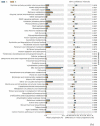Dietary coated essential oil and organic acid mixture supplementation improves health of broilers infected with avian pathogenic Escherichia coli
- PMID: 36712401
- PMCID: PMC9868345
- DOI: 10.1016/j.aninu.2022.09.010
Dietary coated essential oil and organic acid mixture supplementation improves health of broilers infected with avian pathogenic Escherichia coli
Abstract
Colibacillosis caused by avian pathogenic Escherichia coli (APEC) is a very prevalent disease in poultry farms in China. The exploration of effective non-antibiotic substances is of great significance for the control of APEC infections. This experiment evaluated the efficacy of coated essential oil and organic acid (EOA) supplementation to prevent E. coli O78 infection in broiler chickens. A total of 288 one-day-old male broiler chicks were randomly distributed into 4 groups with 6 replicates per group. Chickens were fed a diet either supplemented with EOA (500 mg/kg feed) or not, and either uninfected or infected with E. coli O78 intratracheally. Results showed that E. coli O78 infection reduced body weight gain, increased mortality and the ratio of feed to gain along with cecal and liver E. coli load, damaged gut mucosa, induced local and systemic inflammation, and altered cecal microbial composition, diversity and function (P < 0.05). Supplemental EOA improved feed conversion efficiency, lowered gross lesion scores and cecal E. coli population, enhanced intestinal goblet cells and serum IgG concentration, and tended to decrease serum IL-12 production (P < 0.05). Essential oil and organic acid addition downregulated IFN-γ mRNA, tended to decrease mucin-2 mRNA levels while upregulating IL-10 mRNA, and tended to increase ZO-1 gene expression in the jejuna of infected birds at 7 d after E. coli O78 challenge (P < 0.05). The 16S rRNA gene sequencing indicated that both EOA addition and E. coli O78 challenge altered the diversity and composition of the cecal microbiota community. Furthermore, infected birds fed EOA showed decreased Bacteroidetes and genus Lactobacillus abundance compared with the infected control. LEfSe analysis showed that Firmicutes, Ruminococcaceae, Clostridiales, Clostridia, Lactobacillus, Lactobacilaceae, and cc-115 were enriched in the non-infected but EOA-treated group (P < 0.05). Collectively, dietary EOA supplementation could mildly alleviate E. coli-induced gut injury and inflammation.
Keywords: Avian pathogenic Escherichia coli; Broiler chicken; Encapsulated essential oil and organic acid mixture; Health.
© 2022 The Authors. Publishing services by Elsevier B.V. on behalf of KeAi Communications Co. Ltd.
Conflict of interest statement
We declare that we have no financial and personal relationships with other people or organizations that can inappropriately influence our work, and there is no professional or other personal interest of any nature or kind in any product, service and/or company that could be construed as influencing the content of this paper.
Figures








Similar articles
-
Dietary Enterococcus faecium NCIMB 11181 supplementation mitigates intestinal and systemic inflammation induced by avian pathogenic Escherichia coli O78 infection in broiler chickens.Poult Sci. 2025 Aug 6;104(11):105656. doi: 10.1016/j.psj.2025.105656. Online ahead of print. Poult Sci. 2025. PMID: 40815990 Free PMC article.
-
Dietary supplemental coated essential oils and organic acids mixture improves growth performance and gut health along with reduces Salmonella load of broiler chickens infected with Salmonella Enteritidis.J Anim Sci Biotechnol. 2023 Jul 1;14(1):95. doi: 10.1186/s40104-023-00889-2. J Anim Sci Biotechnol. 2023. PMID: 37391807 Free PMC article.
-
Effect of blending encapsulated essential oils and organic acids as an antibiotic growth promoter alternative on growth performance and intestinal health in broilers with necrotic enteritis.Poult Sci. 2022 Jan;101(1):101563. doi: 10.1016/j.psj.2021.101563. Epub 2021 Oct 25. Poult Sci. 2022. PMID: 34823183 Free PMC article.
-
Effects of encapsulated organic acids and essential oils on intestinal barrier, microbial count, and bacterial metabolites in broiler chickens.Poult Sci. 2019 Jul 1;98(7):2858-2865. doi: 10.3382/ps/pez031. Poult Sci. 2019. PMID: 30715522
-
Modulatory effects of polyherbal mixture on the immuno-antioxidant capacity and intestinal health of chicks infected with Escherichia coli O78.Poult Sci. 2025 Jun;104(6):105156. doi: 10.1016/j.psj.2025.105156. Epub 2025 Apr 12. Poult Sci. 2025. PMID: 40239311 Free PMC article.
Cited by
-
Effects of drinking water supplemented with essential oils and organic acids mixtures on growth performance and intestinal health of broilers challenged with necrotic enteritis.Poult Sci. 2025 Feb;104(2):104712. doi: 10.1016/j.psj.2024.104712. Epub 2024 Dec 20. Poult Sci. 2025. PMID: 39721270 Free PMC article.
-
Palygorskite improves growth performance and prevents liver damage in avian pathogenic Escherichia coli-challenged broiler chickens at an early age.J Anim Sci. 2024 Jan 3;102:skae302. doi: 10.1093/jas/skae302. J Anim Sci. 2024. PMID: 39373204
-
Intestinal differential metabolite tryptophan from avian pathogenic Escherichia coli (APEC)-resistant and susceptible chickens alleviates APEC symptoms in chickens.Poult Sci. 2025 Jul;104(7):105212. doi: 10.1016/j.psj.2025.105212. Epub 2025 Apr 24. Poult Sci. 2025. PMID: 40315585 Free PMC article.
-
Effects of microencapsulated essential oils and organic acids preparation on growth performance, slaughter characteristics, nutrient digestibility and intestinal microenvironment of broiler chickens.Poult Sci. 2024 May;103(5):103655. doi: 10.1016/j.psj.2024.103655. Epub 2024 Mar 16. Poult Sci. 2024. PMID: 38537402 Free PMC article.
-
Chlorogenic acid mitigates avian pathogenic Escherichia coli-induced intestinal barrier damage in broiler chickens via anti-inflammatory and antioxidant effects.Poult Sci. 2025 May;104(5):105005. doi: 10.1016/j.psj.2025.105005. Epub 2025 Mar 7. Poult Sci. 2025. PMID: 40086255 Free PMC article.
References
-
- Abu-Basha E.A., Gharaibeh S.M., Thabet A.M. In vitro susceptibility of resistant Escherichia coli field isolates to antimicrobial combinations. J Appl Poultry Res. 2012;21(3):595–602.
-
- Abudabos A.M., Al-Mufarrej S.I. Effects of organic acid supplementation on antioxidant capacity and immune responses of broilers challenged orally with Salmonella enterica subsp. enterica Typhimurium. South Afr J Anim Sci. 2014;44(4):342–349.
-
- Adaszyńska-Skwirzyńska M., Szczerbińska D. The antimicrobial activity of lavender essential oil (Lavandula angustifolia) and its influence on the production performance of broiler chickens. J Anim Physiol Anim Nutr. 2018;102(4):1020–1025. - PubMed
-
- Adil S., Banday T., Bhat G.A., Salahuddin M., Raquib M., Shanaz S. Response of broiler chicken to dietary supplementation of organic acids. J Cent Eur Agric. 2011;12(3):498–508.
LinkOut - more resources
Full Text Sources

